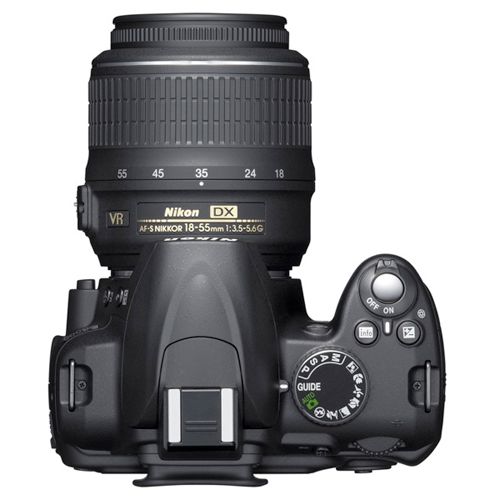With digital SLRs well within the realm of mass-market affordability, what’s to stop every family from owning one? Financial penury aside, a perceived uphill learning curve perhaps, and that’s where Nikon’s latest 10-megapixel entry-level model, the D3000, updating the D60, comes in.
Our quick take
Though this DSLR offers a top resolution of "just" 10 megapixels, we found very little difference comparing results with that of a 12MP model. Indeed the D3000’s combination of lens and sensor provides detailed and crisp results for those looking to achieve photographs that are more professional in appearance.
In terms of light sensitivity, noise begins to intrude into shadow detail from ISO 400, but up to and including ISO 800 it’s kept sufficiently at bay to avoid overall softening and loss of detail. Stray above this however and you risk an image looking more painterly rather than photographic.
More positively, though Nikon, along with its rivals, has long suggested that its consumer DSLR offerings are cameras that can be "grown into", the D3000 is probably the nearest its manufacturer has got to that statement being unequivocally true.

Nikon D3000 DSLR camera - 4.0 / 5
| FOR | AGAINST |
|---|---|
|
|
Chief among its selling points is an Intelligent Guide mode, selected via the top plate dial, that "talks" the user – via brief explanatory text – through which settings are best selected for a range of common shooting requirements. Within the Guide mode there’s a choice of easy or advanced operation. Think of it as a kind of on-board "DSLR photography for dummies", which might have been more newsworthy if Sony hadn’t recently attempted similar with its Alpha A380 DLSR.
In addition there’s a further information button found bottom left of the camera’s back plate. Press this and users are presented with an overview of adjustable settings, pop-up thumbnails illustrating the kind of image you might be attempting in making your selections.
This isn’t to suggest that the degree of hand-holding offered by the D3000 may annoy more seasoned picture takers. There’s still plenty of creative control on offer – not only via the quartet of P, A, S, M modes also found on the top plate dial, but also on board Picture Control options.
These allow the user to switch from standard defaults to neutral, vivid or monochrome colour settings, plus in-camera editing that includes a funky "miniature" setting. Select this if shooting crowds of people from on-high to ape the effects of tilt and shift lenses and make them appear as if ants in a toy town village – adjusted images saved as fresh files alongside the unadulterated originals.
While the above all adds to the fun, there are a couple of notable omissions from the D3000’s feature set. As with the D60 there’s no Live View – the facility via which the rear screen can be used for composing images, as on a compact – nor is there any form of video mode or HDMI port.
Users do however get dust prevention – the camera shakes the chip free of undesirables that may have intruded when swapping lenses upon powering down. And, though there’s no built-in anti-shake, image stabilisation is provided in the shape of the Vibration Reduction equipped 18-55mm zoom lens offered as part of an introductory bundle option. Going for this package currently makes the soundest commercial sense for anyone "buying" newly into the Nikon system.
As you’d expect from the brand, the D3000’s build quality is good, and with lens attached the set up feels solid and sturdy when gripped in the palm – despite the budget pricing and overall small form factor, just marginally larger than the Micro Four Thirds cameras from Olympus (E-P1) and Panasonic (G1/GH1).
In practical terms the users’ nose uncomfortably presses up against the 3-inch, 230k-dot rear LCD when putting an eye level with the viewfinder, as the eye relief doesn't jut out very far. Still, viewfinder visibility is commendably clear and with the main power switch encircling the shutter release button, users can be up and shooting from cold in just over a second, maximum continuous capture speed set at 3 frames per second – par for the course for this class of DSLR.
The camera is quick to lock onto target courtesy of 3D subject tracking and 11 auto focus points spread across the frame – not bad at all for an entry-level model, given the D60 only had three AF points – with whichever is/are in use highlighted in the viewfinder when the shutter button is pressed halfway.
Images, whether JPEG, RAW or a combination of the two (RAW plus "Basic" compression-level JPEG) are quickly committed to regular SD or SDHC card, a covered slot for which is provided on the camera’s right-hand flank.
The consistent D3000 includes the Active D-lighting feature offered throughout the Nikon DSLR range, which automatically sorts out tricky exposures – for example bright backgrounds and dark foregrounds – to provide more even results, with a pop-up flash to fall back on if fill-in illumination is required.
To recap
Though some may find Nikon’s implementation of an on-board help guide with large print text and bright graphics on the D3000 patronising, there’s no denying it’s a clever way to widen its traditionally specialist user base and attract new converts – even if we did miss use of Live View when attempting shots from otherwise tricky angles on occasion
